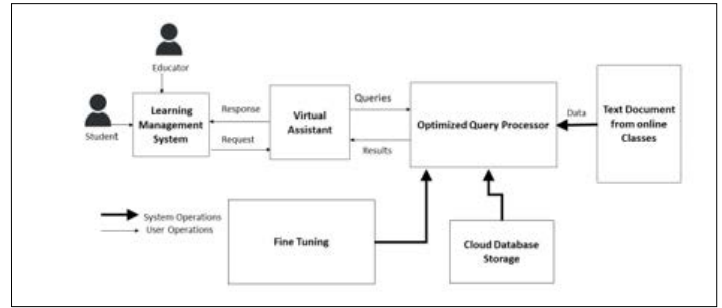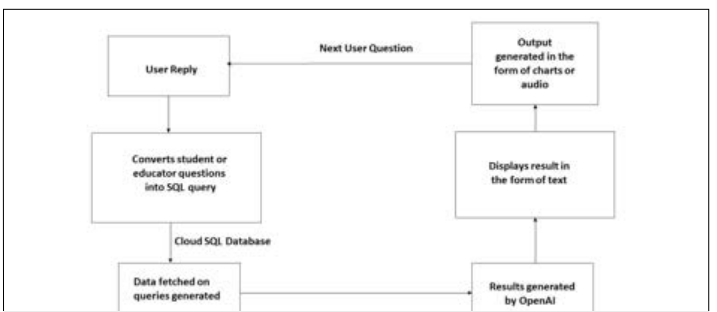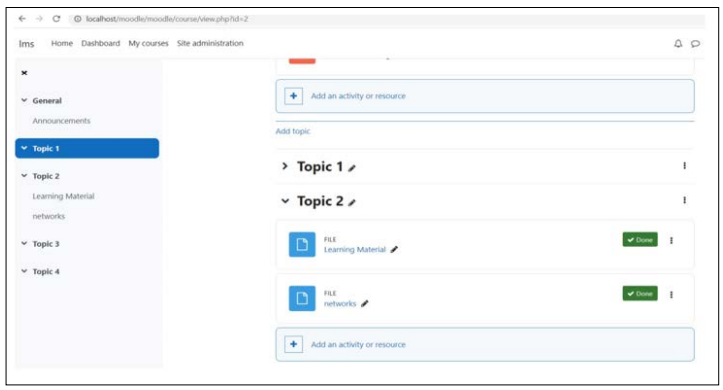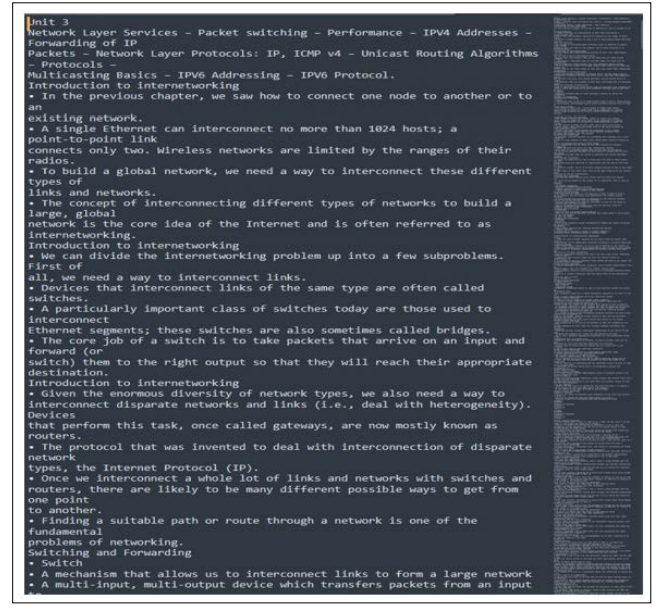Author(s): <p>Surya K* and Ajay Badrinath</p>
In the world of sudden pandemic, there has been always a need to develop interactive and novel solutions in the field of education when compared to other sectors. This is because education is the foundation of all other fields to emerge as it formulates the basis of knowledge sharing. Without sharing the knowledge gained, it is impossible for the humanity to grow in various fields. So, this work aims at giving novel solutions for online education which uses cloud computing to store extensive and large datasets. It also makes use of the generative AI technology in cloud to provide interactive solution to all the users in that online platform. Since generative AI consumes large memory for running the applications, we have used cloud storage. The use of cloud computing also enables the user to connect to the application using internet remotely. This work also makes use of Learning Management System (LMS) which can serve the request of registered users. In this methodology a virtual assistant developed is using generative AI. The registered user can interact with the virtual assistant in the LMS. The model has been developed using quantitative assessment using same set of questions and prompts which comprises of zero-shot, few-shot and fine-tuned training approaches. This proposed approach was able to respond to high proportion of questions through fine-tuning with an accuracy rate of 97%.
In current scenario, a pandemic can occur at any point of time and there is always a need for online education. This work aims to provide interactive teaching assistant which can be configured to moodle which is an open source Learning Management System (LMS), available under the GNU General Public License. It benefits both the teachers as well as students as the developed virtual assistant creates interactive quizzes based on the attached learning material. The virtual assistant engages in interactive conversations with users, simulating teacher-like interactions to the students. To deploy the interactive solutions through moodle, the organization can go for low-cost cloud moodle suite and store all the materials though storage as a service offered by cloud provider.
These interactive communications of the virtual assistant work through generative AI. Here the use of generative AI creates new content from the existing content posted by the teacher during live online classes. Since the creation of new content requires storage resources, we have used cloud for storing the generated content. The developed model has been trained using zero-shot, few-shot and fine-tuned training approaches.
By using GPT-3.5 the zero-shot prompting generates a result without any prior training. Few shot prompting includes the model being trained by some examples to generate the desired results. Fine-tuning optimized the virtual assistant’s output and improved the performance with higher accuracy during interaction. In all these techniques the input is the text document which contains the transcribed content of the online class posted in LMS. Some of the considerations while training the model include tuning the model parameters and measuring the accuracy and computation time of the generated content are taken care in the developed virtual assistant [1]. The users will send the request to the virtual assistant using GenAI models which is deployed in the cloud, and the request will be processed based on the training strategies adopted to train the foundational model.
ChatGPT has been widely used by students in their higher education and the positive factors like trialability, observability is found to be significant, whereas relative advantage, compatibility and complexity are not found to be significant [2]. The various challenges of using chatGPT in the field of higher education like integrity, accuracy, reliability, information bias, and privacy issues needs to be addressed [3-5]. The most important challenge of generative AI must be based on two perspectives: the perspective of law and the perspective of the industry [6]. The copyright issue arriving from the foundational model used the data on the web which becomes an issue while it is being deployed in the moodle which serves as repository of the education material generated.
A systematic review of the purpose of moodle and how it is used in the field of STEM (Science, Technology, Engineering, Mathematics) in various universities are analysed [7]. The various steps to integrate the ChatGPT plugin into moodle is summarized in this research paper [8]. It also summarizes the challenges of using chatgpt and the type of training that must be provided to students and teachers if the chatgpt plugin is deployed on moodle [8]. The students were randomly divided into two groups one who were trained by ChatGPT and another group without using chatgpt on weekly programming classes. Research results revealed that the students trained using additional ChatGPT based learning outperformed the other group [9]. Another case study was done on two groups namely students and the educators using generative AI for delivering lectures and assessment on students. These results revealed that moderate use of generative AI in education boosted the critical thinking in students [10].
The data was collected through surveys in three Arab countries including Oman, Jordan and Yemen and the results proved that using generative AI increased the creative thinking of the students [11]. The study involved a user workshop with 15 high school students from Northern Thailand, which consisted of both quantitative and qualitative analyses to assess their experience with generative AI in creative content generation [12]. These results proved that generative AI increased the creativity as well as critical thinking among the high school students [12]. The use generative AI in education and inclusive approach to their integration with online teaching has been analysed in this work [13]. Generative AI can assist students in a variety of tasks, including information search, answering questions related to specific subjects, and enhancing writing in a variety of languages [14]. For teachers, ChatGPT can assist in generating teaching plans, preparing teaching materials (e.g., scripts, slides, and quizzes), reviewing and grading assignments, and providing feedback to students [14,15]. The literature of generative AI applications by taking the input from students of Yemen proved that the students from from Arab region showed increase in efficiency of learning, also improved the use of these technologies in higher education [16]. Artificial Intelligence-Generated Content (AIGC) offers a wide range of applications in almost all fields. But the generated content will face latency issues when the IoT devices are connected as the content generation takes place in cloud [17].
The transitions that must be taken care of when using AI in the field of Human Computer Interaction (HCI) and some of the alternative solutions to address the challenges of human-centered AI (HCAI) approach has been reviewed in this article [18]. The use of generative AI in LMS creates a large amount of new data on the Internet, enabling it to go for cloud storage. The cloud provider uses the generative AI to grant resources for the application which uses GenAI [19]. Thus, generative AI has become revolutionary and advantageous in almost all fields of technology that aims to provide creative solutions.
A local instance of the moodle server was configured and run using Apache Server and MariaDB as back-end data base engine. By using the local AI connector available with the moodle chatgpt is used for building the interactive virtual assistant. The material is that is taught in the class are posted into the LMS which can be accessed using internet connectivity over moodle mobile app or web browser. The LMS data are stored at specific intervals of time in cloud storage. The cloud storage serves as a repository of all the files posted in lectures.
The virtual assistant developed by generative AI performs the following actions like summarization of the teaching material, transcript of the video uploaded in the LMS, also recommends the user about the possible questions. The virtual assistant also acts like their teacher after the online classes get over. By using generative AI improves the ability of all types of students, also reduce the burden of teachers and trainers from repetitive administrative tasks. It also stores the personalized information of all the students and teachers in a centralized encrypted form in the cloud. Thus, the privacy of users using the LMS is guaranteed when using cloud storage.

Figure 1: System Architecture

Figure 2: Query Processing by Interactive Virtual Assistan
The input file is the transcript of the video session held in online classes. The document is parsed by the virtual assistant using OpenAI APIs and the results are given as a chat conversation by the interactive virtual assistant. The main advantage of this chatbot is that students who missed the online classes due to poor internet connectivity can make use of this virtual assistant in understanding. The concepts can be understood well as it consumes less bandwidth compared to watching a video. Then the conversation between the user and interactive chatbot is logged using the thread id generated in by the OpenAI API.
Then the next question of the user is queued by the queueing model and the status of the thread is changed based on the user query. This process is continued until the registered user presses the exit button to stop interaction.
The figure 3 shows the moodle setup where the notes are being uploaded by the trained. Then OpenAI’s GPT is integrated into the moodle which process the text document as shown in figure 4.

Figure 3: Integration with LMS

Figure 4: Text Summarization by Virtual Assistant
The current implementation includes text summary in figure 4 and it can display the possible question after processing the posted material in the LMS. The time taken for the operation was almost 2 minutes for a document with approximately 10,000 words. The experiment was repeated on different datasets which had different content. The generated text summary was 95 % percent accurate without any errors. The question formation from the processed document proved to be 97 % accurate with fine tuning approaches. Some of the parameters which was set for our implementation included temperature, which was set to 0.6, maxTokens being set to 5000, frequency penalty set to 0.2 and presence penalty to 0.3 respectively.
This work summarizes the use of generative AI which can generate content in the form of text summary, conversation and provide exercises for assignment, exams in an interactive way. The future work would be to integrate the other languages in the developed virtual assistant. This will benefit the students using their mother tongue as medium of instruction. The accuracy of the generative AI model in 97% in the developed solution using fine tuning approach. The user interface and the deployment of interactive virtual assistant can be improved in the future work.
